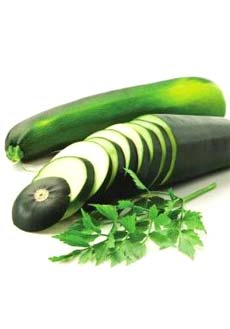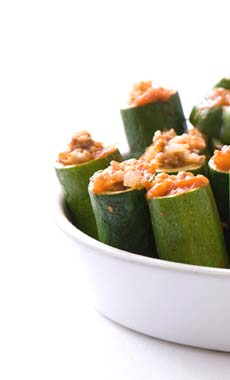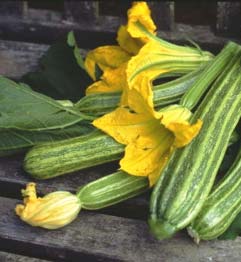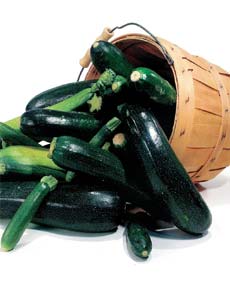|
|
Zucchini : A Multi Health Benefit Powerhouse

Zucchini or courgette is a summer squash belonging to the species Cucurbita pepo.
Zucchini can be dark or light green. Botanically, however, zucchini is an
immature fruit, being the swollen ovary of the zucchini flower.
In North America, Australia, Germany and Scandinavia the plant is commonly
called a zucchini. The name is derived from the word, zucchina (small pumpkin).
A zucchini with the flowers attached is a sign of a truly fresh and immature
fruit, and is especially sought by many people for its sweeter flavor. Unlike
cucumber, zucchini is usually served cooked. It is prepared using a variety of cooking techniques,
including steamed, boiled, grilled, stuffed and baked, barbecued, fried, or
incorporated in other recipes such
as souffl�s.
The zucchini has a delicate flavor and requires little more than quick cooking
with butter or olive oil, with or without fresh herbs.
The skin is left in place. Quick cooking of zucchini in oil or butter allows
the fruit to partially boil and steam, with the juices concentrated in the final
moment of frying when the water has dried, prior to serving. Zucchini can also
be eaten raw, sliced or shredded in a cold salad, as well as lightly cooked in
hot salads, as in Thai or Vietnamese recipes. Mature (larger sized) zucchini are
well suited for cooking in breads.
Zucchini should not be stored for more than three days. They are prone to chilling damage which shows as sunken pits in the surface of the fruit, especially when brought up to room temperature after cool storage. |
According to the USDA: One cup of sliced, boiled zucchini with skin has 27
calories, 2 g protein, 2 g fiber, 5 g carbohydrates and 1 g fat. Vitamins and
minerals include 2,011 international units (IU) vitamin A, 23 mg vitamin C, 50
mcg folate, 0.3 mg manganese, 475 mg potassium and 32 mg calcium.
Counting Health Benefits of Zucchini
According to the USDA: One cup of sliced, boiled zucchini with skin has 27
calories, 2 g protein, 2 g fiber, 5 g carbohydrates and 1 g fat. Vitamins and
minerals include 2,011 international units (IU) vitamin A, 23 mg vitamin C, 50
mcg folate, 0.3 mg manganese, 475 mg potassium and 32 mg calcium.
Low Calorie Food
One cup of zucchini has 36 calories and 10% of the RDA of dietary fiber, which
aids in digestion,
prevents constipation,
maintains low blood sugar and curbs over-eating.
A healthy serving of this vegetable delivers less than 25 calories, an almost
unheard of number in the general roster of calorie counts.
Lower Cholesterol Level
The dietary fiber in zucchini helps lower cholesterol by
attaching itself to bile acids that the liver makes from cholesterol for
digesting fat.
Because fiber binds so well with bile acid, thus crowding its ability to
immediately digest fat, the liver is charged with producing more bile acid. The
liver then draws upon even more cholesterol to produce bile acid, consequently
lowering the overall cholesterol level in the body. Furthermore, the high levels
of vitamin C and vitamin A prevent cholesterol from oxidizing in the body's
blood vessels, thus hampering the onset of atherosclerosis.
 An
Antioxidant An
Antioxidant
Because dietary fiber promotes healthy and regular bowel
movements,
the high amounts of fiber in zucchini also help prevent carcinogenic toxins from
settling in the colon. Moreover, the vitamins C and A, as well as folate, found
in zucchini act as powerful antioxidants that fight oxidative stress that can
lead to many different types of cancer.}
Zucchinis, especially golden skin varieties, are rich in flavonoid poly-phenolic
antioxidants such as carotenes, lutein
and zea-xanthin. These compounds help scavenge harmful oxygen-derived
free radicals and reactive oxygen species (ROS) from the body that play a
role in aging and
various disease processes.
Anti-Inflamatory
Vitamins C and A present in Zucchini not only serve the body as powerful
antioxidants, but also as effective anti-inflammatory agents. Along with the
copper found in zucchini, these vitamins prevent the development of
hyper-inflamatory disorders, including asthma, osteoarthritis,
and rheumatoid arthritis.
Heart Attack and Stroke Prevention
A one cup serving of zucchini contains over 10% of the RDA of magnesium, a
mineral proven to reduce the risk of heart attack and stroke. Zucchini also
provides folate,
a vitamin needed to break down the dangerous amino acid homocysteine, which - if
levels in the body shoot up - can contribute to heart attack
and stroke.
Lower Blood Pressure
Along with magnesium, the potassium found in zucchini helps lower blood
pressure. If unchecked, hypertension,
or high blood pressure, can lead to arteriosclerosis (blood vessel damage),
heart attack, stroke, and many other serious medical conditions. Both the
potassium and magnesium in zucchini, however, can help alleviate the stress on
the body's circulatory system.
One cup of zucchini contains 19% of the RDA of manganese, which helps the body metabolize protein and carbohydrates, participates in the production of sex hormones, and catalyzes the synthesis of fatty acids and cholesterol. The manganese in zucchini also increases the levels of superoxide dismutase (SOD), the enzyme responsible for protecting mitochondria against oxidative stress. Finally, manganese is essential for the production of proline, and amino acid that allows collagen to form, thus allowing for healthy skin and proper wound-healing. |
High Water Content
Hydration is another important element of diet. Eating cheesy, doughy
foods with high sodium levels or other processed choices can leave your
body gasping for water. This doesn�t happen with zucchini and other
green vegetables that have a lot of water in them (One cup of sliced,
boiled zucchini has 171 g water).
Concentrated Source of Vitamins & Minerals
 Moderate
source of folate, zucchini provides 24 �g or 6% of RDA per 100 g. Folate is
important in cell division and DNA synthesis. When taken adequately before
pregnancy, it can help prevent neural tube defects in the fetus. Zucchini is a
very good source of potassium, an important intra-cellular electrolyte.
Potassium is a heart friendly electrolyte and helps bring the reduction in blood
pressure and heart rates by countering pressure-effects of sodium.
Another element that zucchini has is beta-carotene. This essential vitamin is
found in the rind of the zucchini, so do not skin this plant before cooking it.
Do wash the rind thoroughly before cooking. Zucchini contain moderate levels of
B-complex group of vitamins like thiamin, pyridoxine, riboflavin and minerals
like iron, manganese, phosphorus, and zinc. Moderate
source of folate, zucchini provides 24 �g or 6% of RDA per 100 g. Folate is
important in cell division and DNA synthesis. When taken adequately before
pregnancy, it can help prevent neural tube defects in the fetus. Zucchini is a
very good source of potassium, an important intra-cellular electrolyte.
Potassium is a heart friendly electrolyte and helps bring the reduction in blood
pressure and heart rates by countering pressure-effects of sodium.
Another element that zucchini has is beta-carotene. This essential vitamin is
found in the rind of the zucchini, so do not skin this plant before cooking it.
Do wash the rind thoroughly before cooking. Zucchini contain moderate levels of
B-complex group of vitamins like thiamin, pyridoxine, riboflavin and minerals
like iron, manganese, phosphorus, and zinc.
Popular varieties of Zucchini
-
Golden zucchini features brilliant golden-yellow skin that retains its
color even after cooking.
-
Round varieties are dense, heavy, and nearly seedless with smooth
surface.
-
Tatume, which is common in Mexico, has similar features of round variety
but has the large oval shape.
-
Costata romanesco also known as cocozelle is a long, narrow variety with
the slight bulge at the bottom end. It features pale raised ribs in
mottled green skin. When solid and young, this squash is juicy and
sweet.
-
Middle-Eastern types are stocky, pale green, tapering ends with a thick
dark-green stem. They have smooth shiny skin and solid, crispy and
flavorful flesh.
Cooking Around the World
-
 In Mexico, the flower (known as flor de calabaza) is often cooked in
soups or used as a filling for quesadillas. The fruit is used in stews,
soups (i.e. caldo de res, de pollo or de pescado, mole de olla, etc.)
and other preparations. Both the flower and the fruit are eaten readily
throughout Mexico. In Mexico, the flower (known as flor de calabaza) is often cooked in
soups or used as a filling for quesadillas. The fruit is used in stews,
soups (i.e. caldo de res, de pollo or de pescado, mole de olla, etc.)
and other preparations. Both the flower and the fruit are eaten readily
throughout Mexico.
-
In Italy, zucchini is served in a variety of ways, especially breaded
and pan-fried. Some restaurants in Rome specialize in deep-frying the
flowers, known as fiori di zucca.
-
In France zucchini are a key ingredient in ratatouille, a stew of summer
fruits and vegetables prepared in olive oil and cooked for an extended
time over low heat. The dish, originating near present-day Nice, is
served as a side dish or on its own at lunch with bread. Zucchini are
stuffed with meat with other fruits like tomatoes or bell peppers in a
dish named courgette farcie (stuffed zucchini).
-
In Turkey, zucchini is the main ingredient in the popular dish m�cver,
or "zucchini pancakes", made from shredded zucchini, flour and eggs,
lightly fried in olive oil and eaten with yogurt. They are also used not
infrequently in kebabs along with various meats.
-
In the Levant, zucchini is stuffed with minced meat and rice plus herbs
and spices and steamed. It is also used in various kinds of stew. Stews
that have low salinity are favorable in such cooking. It can also be
stuffed with a mixture of rice, meat and eaten with yogurt.
-
In Greece, zucchini is usually fried or boiled with other fruits (often
green chili peppers and eggplants). It is served as an hors d'�uvre or
as a main dish, especially during fasting seasons. Zucchini is also
often stuffed with minced meat, rice and herbs and served with
avgolemono sauce. In several parts of Greece, the flowers of the plant
are stuffed with white cheese, usually feta or mizithra cheese, or with
a mixture of rice, herbs and occasionally minced meat. Then they are
deep-fried or baked with tomato sauce in the oven.
-
In Bulgaria, zucchini is fried and then served with a dip, made from
yogurt, garlic and dill. Another popular dish is oven-baked
zucchini�sliced or grated�covered with a mixture of eggs, yogurt, flour
and dill.
-
In Egypt, zucchini is cooked with tomato sauce, garlic and onions.
How
do you like Zucchini, do share with us.
Dated 29 January 2013
Related Links
|
|
|
|
|
|
|









